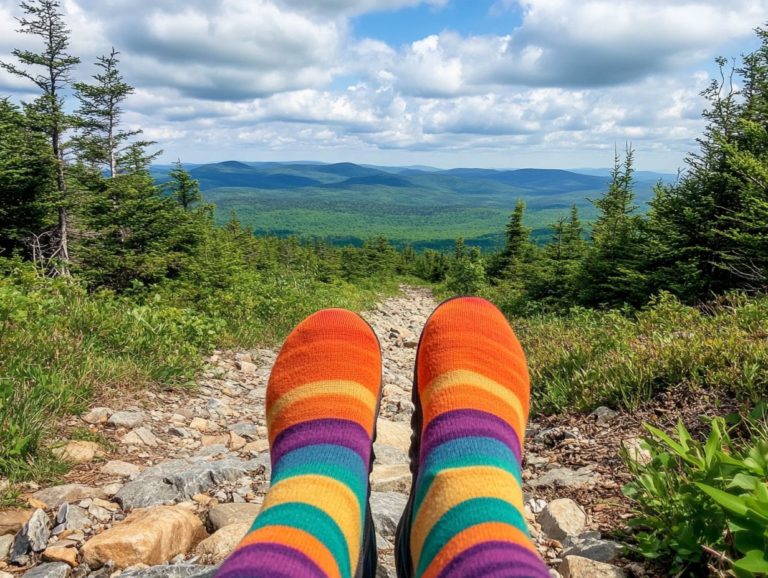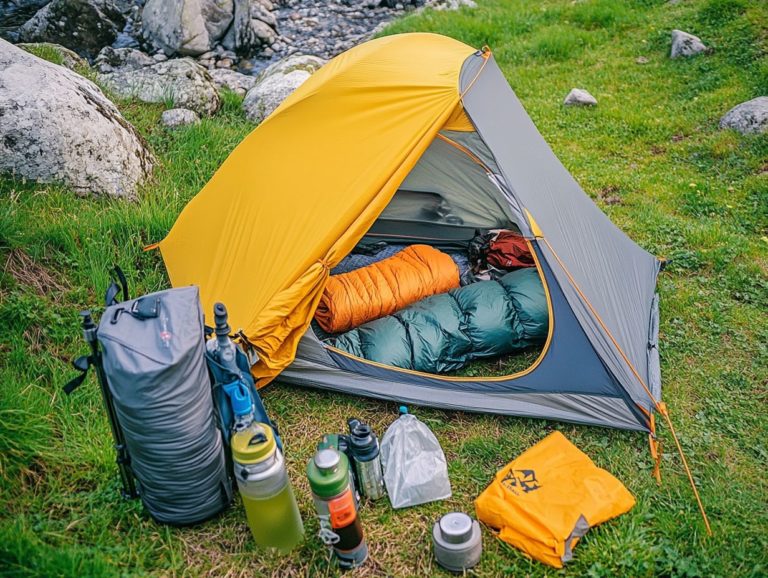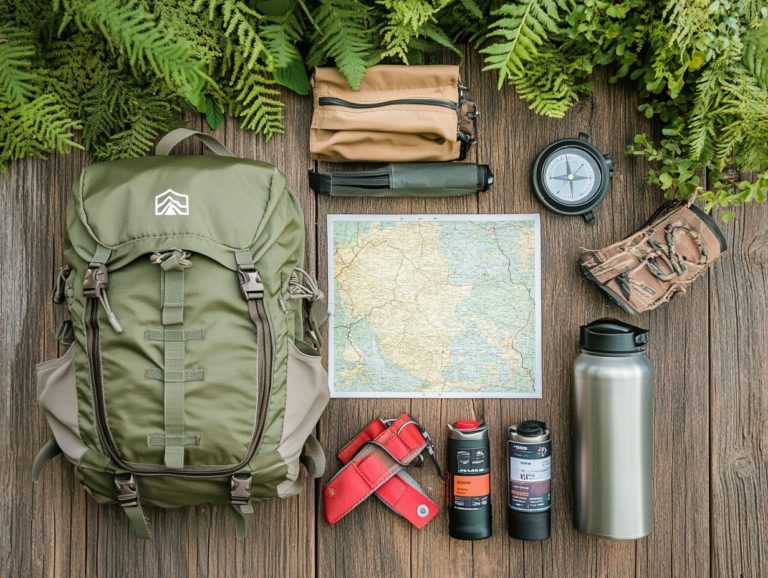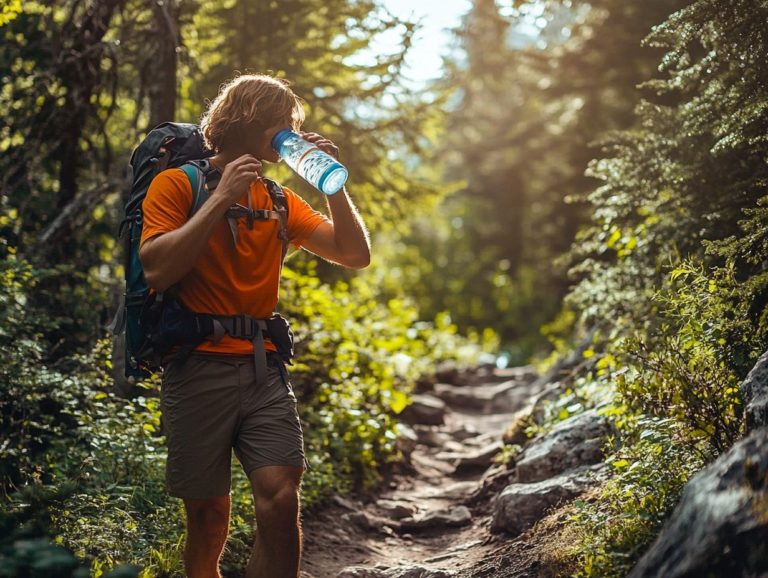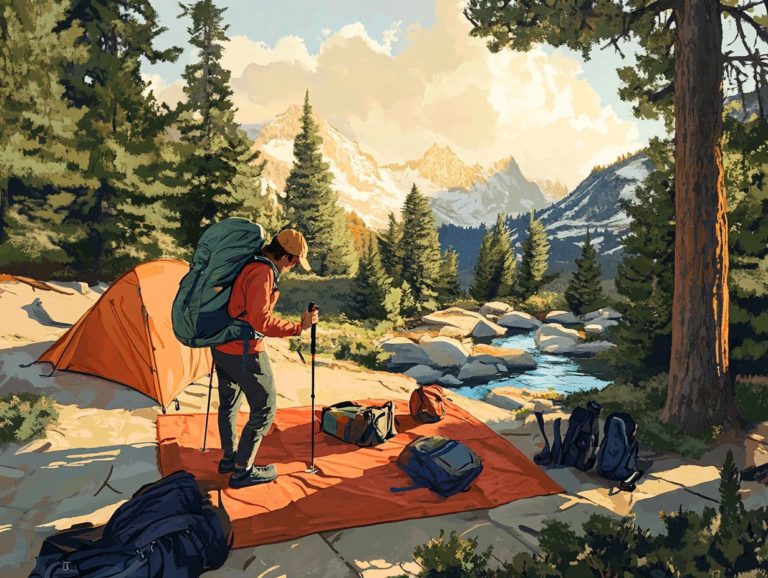How to Protect Your Gear While Hiking
When you set off on a hike, the last thing you want on your mind is whether your gear is safe and sound.
Ensuring proper protection for your equipment not only elevates your outdoor experience but also prepares you for whatever challenges nature might present.
This article delves into the essential items you ll need for a safe hike, effective packing strategies, and protective measures to keep your gear in peak condition.
It also shines a light on common pitfalls to avoid and offers invaluable tips for navigating unexpected weather changes or accidents.
Gear up for an unforgettable adventure!
Contents
- Key Takeaways:
- Essential Gear for Hiking
- Tips for Protecting Your Gear
- Common Gear Protection Mistakes
- Emergency Gear Protection
- Frequently Asked Questions
- What are some essential items for protecting your gear while hiking?
- How can I prevent my gear from getting wet while hiking?
- What should I do if it starts raining while I’m hiking?
- How can I protect my gear from getting damaged on rough terrain?
- What should I do to protect my electronic gear while hiking?
- What should I do with my gear at night while camping?
Key Takeaways:

- Always pack essential gear like a first aid kit, map, and appropriate clothing to ensure a safe and enjoyable hike.
- Proper preparation and packing strategies, such as using waterproof bags and storing gear in compartments, can help protect your gear while hiking.
- In case of unexpected weather or accidents, it is important to have emergency gear protection measures in place, like carrying extra layers and a reliable rain cover for your pack.
The Importance of Gear Protection
When you set out on a hiking adventure, the importance of protecting your gear cannot be overstated. Keeping your gear safe from potential hazards not only enhances your outdoor experience but also ensures your safety throughout the journey. By grasping the significance of trail safety and adhering to the “Leave No Trace” principles, you can enjoy your excursions with peace of mind, fully aware that your gear is shielded from environmental challenges and unforeseen mishaps.
As a hiker, you face a variety of risks, including sudden weather changes, rough terrain, and encounters with wildlife. For instance, a sudden downpour can turn a dry trail into a treacherous, slippery slope, highlighting the necessity for waterproof gear to maintain grip and traction. To enhance your hiking experience, consider the top hiking gear accessories you need; sharp rocks or branches can easily damage your backpack and other equipment if they’re not reinforced with protective coverings.
By investing in high-quality gear protection, you’re not just extending the lifespan of your equipment; you’re also enhancing your overall trekking experience. For a comprehensive preparation, consider the ultimate checklist for hiking gear. This allows you to navigate through nature’s beauty with confidence, free from undue stress or concern.
Essential Gear for Hiking
Essential gear for hiking encompasses a range of items that elevate both your safety and enjoyment on the trails. Start with a pair of proper hiking boots that offer the necessary support and traction, ensuring each step is confident and secure.
A reliable hydration system is equally important, keeping you refreshed as you explore the great outdoors. Don t overlook the significance of a well-stocked first aid kit it’s crucial for addressing any minor injuries that may arise.
A multi-tool can also prove invaluable in various situations, providing versatility when you need it most. Lastly, an LED headlamp is a must-have for navigating after dark, transforming your hiking experience into one of adventure and discovery.
Must-Have Items for a Safe and Enjoyable Hike
When you prepare for a hike, certain essential items can significantly enhance your safety and enjoyment. Sun protection gear, like clothing with ultraviolet protection factor (UPF) and wide-brimmed hats, is vital for shielding yourself from harmful UV rays. Carrying an emergency shelter will keep you ready for unexpected weather changes, while a waterproof jacket ensures you stay dry during those surprise rain showers. Don’t forget nutritious hiking snacks, such as trail mix and electrolyte packs, to keep your energy levels up throughout the journey.
Incorporating high-quality sunscreen into your gear is also key, providing an extra layer of defense against sunburn, especially on long hikes in exposed areas. For those unforeseen situations, a well-stocked first aid kit can be a lifesaver, containing essentials like band-aids, antiseptic wipes, and pain relievers to tackle minor injuries.
Hydration is critical, and bringing a reusable water bottle or hydration bladder will help you stay adequately hydrated, enhancing both your performance and comfort. With these items in tow, you can embark on your outdoor adventures with confidence, knowing you re prepared for various conditions while fully embracing the beauty of nature.
Tips for Protecting Your Gear

Protecting your hiking gear is essential for ensuring its longevity and effectiveness during your outdoor adventures. Regular maintenance, such as applying water-resistant spray, can significantly improve your equipment’s durability against the elements.
Selecting high-quality outdoor fabrics is also important. These fabrics are designed to withstand the rigors of hiking, ensuring your gear endures the test of time and remains fully functional for all your explorations.
Preparation and Packing Strategies
Effective preparation and packing strategies are crucial for an enjoyable hiking trip. Organizing your gear with essential precautions means you ll have everything you need at your fingertips.
This thoughtful approach not only enhances your safety but also amplifies your enjoyment of the great outdoors. Don t wait! Compile a comprehensive checklist that includes vital items such as:
- Map: This helps you navigate through your hiking route.
- Compass: Use this to find your bearings.
- First aid kit: Essential for treating minor injuries.
- Sufficient water: Stay hydrated on your adventure.
Make sure your emergency contacts are noted and easily accessible this could be lifesaving if you encounter challenges on the trail. Engaging in pre-packing and discussing roles and responsibilities with your group can streamline the entire process, ensuring that everyone knows their part.
By embracing these organizational methods, you cultivate a sense of readiness that enriches your hiking experience while protecting against potential mishaps.
Protective Measures on the Trail
Protecting yourself on the trail is a must! It keeps you safe and your gear in top shape. Using a signal mirror can be a game-changer in emergency situations, enhancing your visibility to potential rescuers. A personal locator beacon is a device that helps rescuers find you if you get lost, offering peace of mind when hiking in remote areas. These precautions can greatly enhance your overall hiking experience by prioritizing safety.
Carrying a whistle can be invaluable for signaling your location, as sound travels much farther than your voice. Additionally, knowing how to stay warm while hiking is crucial for comfort and safety. Storing your gear in waterproof bags shields it from unexpected rain or river crossings, keeping everything dry and intact.
Choosing the right clothing, such as moisture-wicking layers, is key to preventing hypothermia and discomfort during those long hikes. It s also wise to keep a well-stocked first-aid kit on hand, ensuring you re equipped to handle minor injuries quickly and effectively.
By incorporating these protective strategies, you can embrace the trail with greater confidence and security.
Common Gear Protection Mistakes
Understanding common gear protection mistakes enables you to maintain your hiking equipment effectively over time. One prevalent error is neglecting regular maintenance, which can lead to damage from environmental conditions.
Overlooking the significance of carrying an emergency kit can leave you unprepared for accidents or unforeseen circumstances. Prioritizing these aspects ensures that you re not only ready for the trail but also equipped for any surprises along the way.
Missteps to Avoid for Gear Longevity
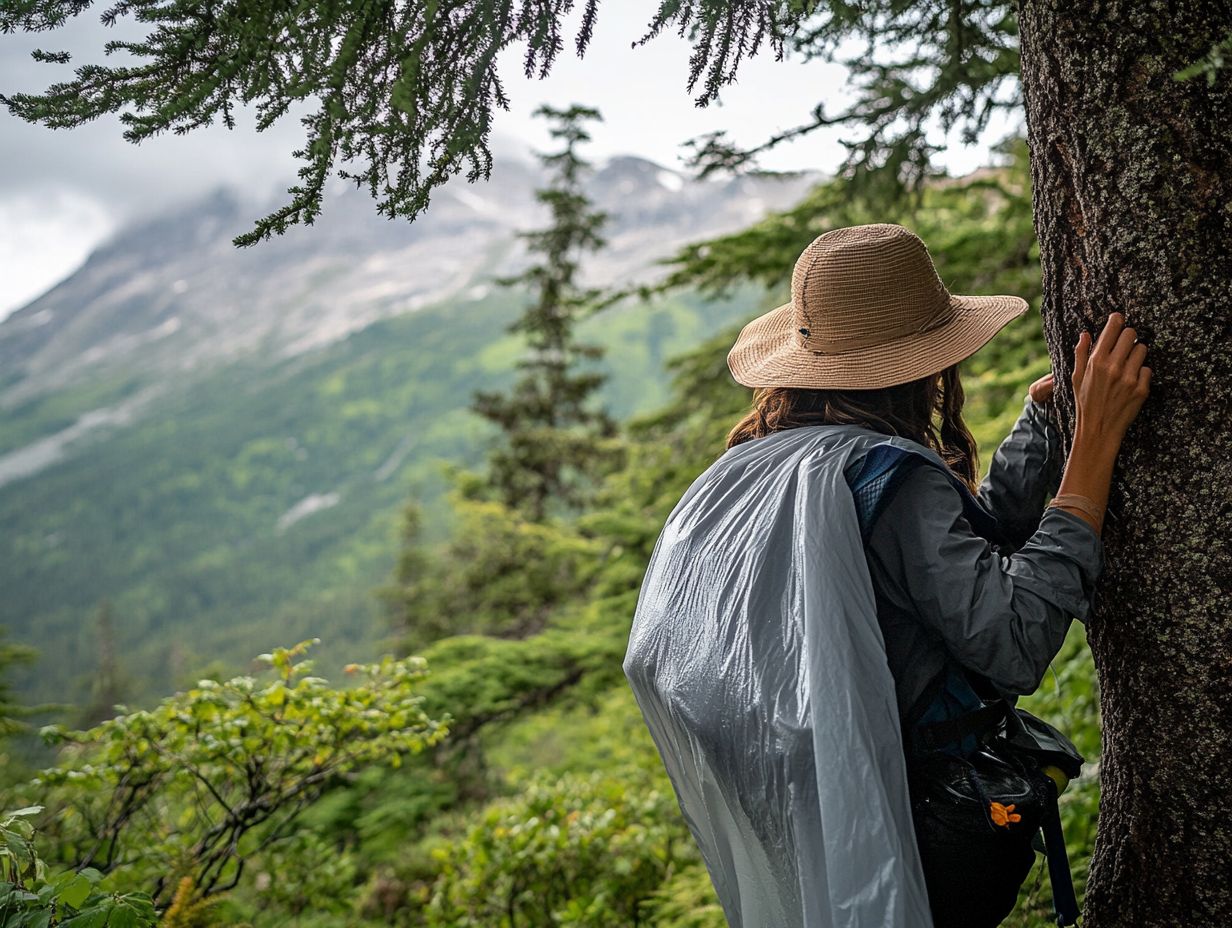
To ensure the longevity of your gear, it s essential to sidestep certain missteps that could undermine your hiking equipment. Improper storage like leaving your gear exposed to moisture or direct sunlight can lead to damage. Neglecting maintenance, including ignoring minor repairs, can spiral into significant issues later, compromising overall gear protection.
For instance, synthetic fabrics can become weakened by prolonged UV exposure, while metals may develop rust if they aren t thoroughly dried before storage. Regularly cleaning your equipment is also crucial, as dirt and grime can trap moisture and create an inviting environment for mildew or corrosion. Using breathable storage bags and keeping your gear in a cool, dry place will help shield it from environmental damage.
By cultivating good habits in maintenance and storage, you can ensure that your investments withstand the rigors of nature, allowing you to embark on countless adventures without the worry of unexpected gear failures.
Emergency Gear Protection
Emergency gear protection is vital for hikers. When you have a comprehensive first aid kit and a reliable hydration system, you’re ready for the unexpected.
This preparation safeguards your well-being in critical situations. You’ll enjoy your hike with more confidence, knowing you can handle whatever nature brings.
What to Do in Case of Unexpected Weather or Accidents
Unexpected weather or hiking accidents can test your safety. Start by assessing if you should seek shelter or continue your hike.
If you’re in a life-threatening situation, activate your personal locator beacon, a device that helps rescuers find you. Make sure your emergency contacts know your plans before you head out.
Be aware of your surroundings. If conditions get worse, seek sturdy natural cover or a designated shelter.
Always carry a map and compass as backups since technology can fail. Familiarizing yourself with your route and potential hazards is crucial.
If an accident happens, stay calm and assess your injuries. If you can’t move, remain visible and stay put until help arrives.
It’s also vital to tell someone your estimated return time. This way, they can alert authorities if you don’t come back as expected.
Frequently Asked Questions
What are some essential items for protecting your gear while hiking?
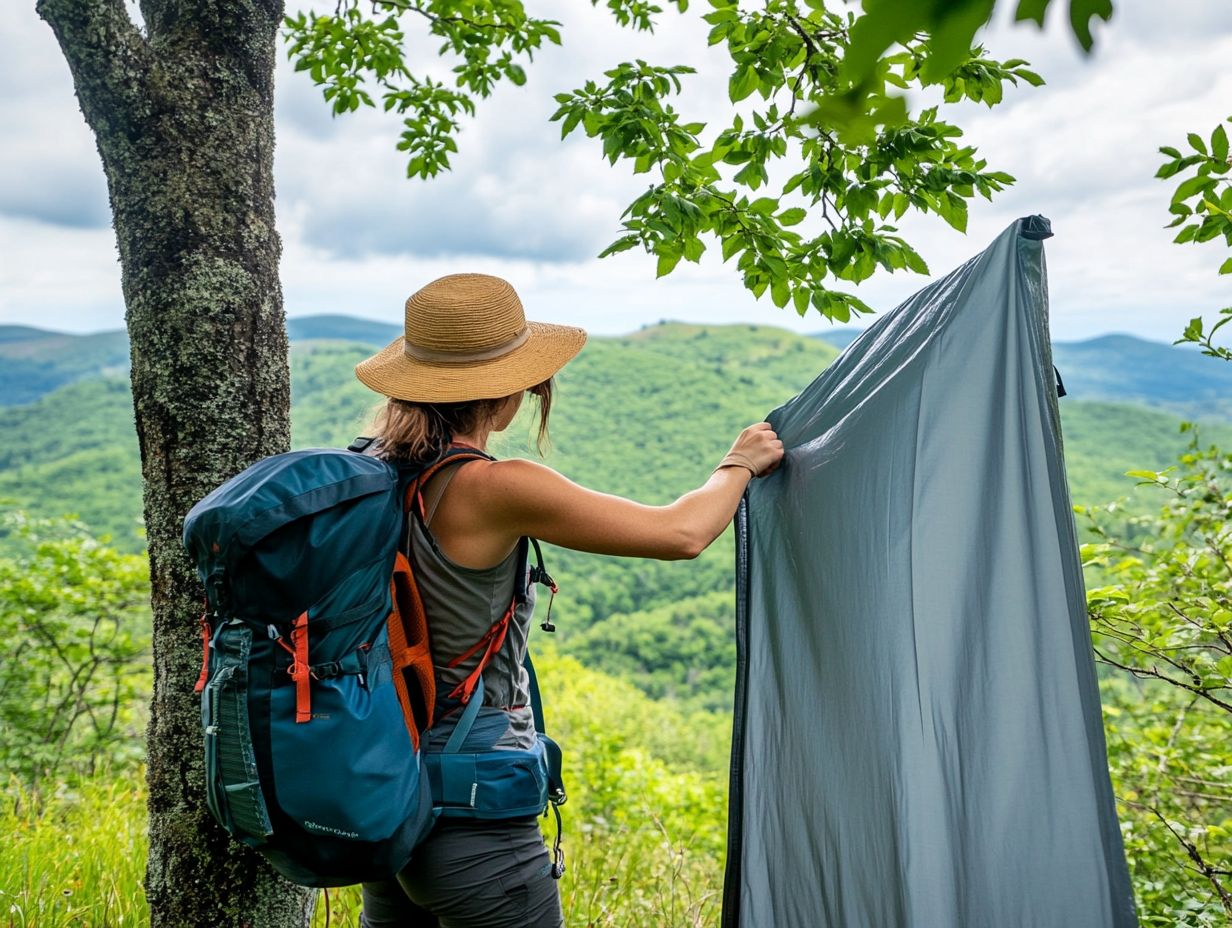
Essential items for protecting your gear include a durable backpack, waterproof covers, and dry bags for electronics. Don’t forget weather-appropriate clothing and a multi-tool for emergencies.
How can I prevent my gear from getting wet while hiking?
To prevent your gear from getting wet while hiking, invest in a waterproof backpack cover or line your backpack with a waterproof liner. Pack your gear in individual dry bags for extra protection.
What should I do if it starts raining while I’m hiking?
If it starts raining while you’re hiking, quickly take out your waterproof covers or dry bags and cover your gear. If you don’t have these items, try to find shelter and wait for the rain to pass.
How can I protect my gear from getting damaged on rough terrain?
To protect your gear from getting damaged on rough terrain, pack it tightly and secure it in your backpack. Consider using a backpack with extra padding and reinforcement. Also, remember to practice leave no trace principles to preserve the environment.
What should I do to protect my electronic gear while hiking?
Protect your electronic gear while hiking by packing it in a separate dry bag or a waterproof case. Investing in a waterproof backpack will keep your devices safe.
Consider carrying a signal mirror for emergencies and an LED headlamp for visibility at night. These items can be lifesavers!
What should I do with my gear at night while camping?
Secure your gear to keep it safe from animals and weather threats! Store it in a tent or under a tarp, and cover it with a waterproof cover if necessary.
A tent with good protection features will help ensure a peaceful night s sleep.

